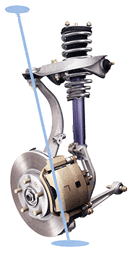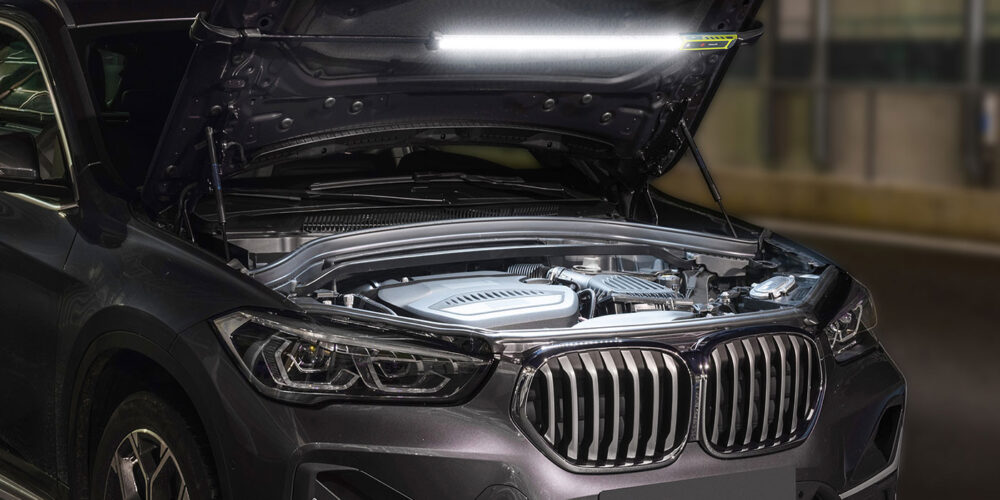Every story has an angle, and this one is no exception. In this case, we’re looking at one of the fundamental wheel alignment angles: caster.
Caster is defined as the forward (negative) or rearward (positive) tilt of the steering axis as viewed from the side. Caster is measured in degrees from an imaginary line perpendicular (90 degrees) to the road surface. Zero caster would be a line straight up and down.
 When the wheels are steered to either side, they pivot on the steering axis. On vehicles with short arm long arm (SLA) suspensions, the steering axis is the line between the upper and lower ball joints. On vehicles with MacPherson struts, the steering axis is the line from the lower ball joint to the top of the strut rod where it attaches to the upper strut bearing plate.
When the wheels are steered to either side, they pivot on the steering axis. On vehicles with short arm long arm (SLA) suspensions, the steering axis is the line between the upper and lower ball joints. On vehicles with MacPherson struts, the steering axis is the line from the lower ball joint to the top of the strut rod where it attaches to the upper strut bearing plate.
Think of caster as the hinge line on which the wheels pivot when they are steered. If the line is perfectly straight up and down (zero caster), the wheels will swing to either side like shutters on a window frame. In other words, they don’t tilt up or down, or lean in or out.
As long as the steering axis is straight up and down (zero caster), the front wheels and tires will remain perpendicular to the road surface when the wheels are steered to either side. This provides maximum contact between the tread and road.
If the steering axis is tilted slightly to the rear (positive caster), it will make the wheels lean or tilt slightly when they are steered. Positive caster causes the top of the inner wheel to tilt outward as the wheel swings out, and the top of the outer wheel to tilt inward as it swings in. The effect is something like leaning into a turn on a bicycle. It actually helps the vehicle corner better by shifting the weight to the outer edge of the inner tire and the inner edge of the outer tire.
There’s more. Adding caster causes the wheels to lift the suspension slightly as they steer. This occurs because positive caster causes the inner wheel spindle to tilt down as it steers, and the outer spindle to tilt up. The net effect is that it increases steering effort, but also uses the weight of the vehicle to push the wheels back to the straight ahead position after making a turn. In other words, it improves steering return and steering stability – especially at higher speeds.
Tilting the top of the steering axis backward a few degrees also produces a “caster effect” that improves steering stability. The front caster wheels on a grocery store shopping cart are offset slightly so they will be self-centering when you push the cart forward. This occurs because the wheel axles are offset slightly to the rear, placing the load of the shopping cart slightly ahead of the axles. The same thing happens in a vehicle with positive caster. If the line through the steering axis is extended until it touches the road, the point of contact will be slightly ahead of the center patch of the tire tread. This produces a “caster effect” that improves stability.
Most vehicles have a certain amount of positive caster to provide quick steering return and high-speed stability. Tilting the top of the steering axis to the rear just a few degrees makes a big difference in the way the vehicle handles and feels at highway speeds. On most vehicles, it only takes 1 to 3 degrees of caster to achieve the desired effect. But on some European sedans and performance cars, more caster is used to enhance high-speed handling. Mercedes-Benz, for example, specifies up to 10 to 11 degrees of positive caster for many of its models. BMW typically calls for 8 to 9 degrees of positive caster. A Chevrolet Corvette, by comparison, may have a specification of 5-1/2 to 6 degrees of positive caster.
But too much of a good thing can be counterproductive. Too much caster can make the steering feel heavy and stiff, which is just the opposite of how a good handling car should feel. Too much caster also increases feedback and makes the steering feel harsh, which may be OK for a racecar driver, but not for your average soccer mom.
So suspension engineers aim for a caster angle that provides the best compromise of steering stability, steering effort, steering return and steering feel for a given vehicle application. That’s why you’ll find significant differences in caster angle specifications by year, make and model of vehicle.
Effects On Tire Wear
Caster is a weird angle because it doesn’t affect tire wear directly, but rather indirectly because of caster’s influence on camber (the inward or outward tilt of the wheels as viewed from the front).
The tilt of the steering axis causes camber alignment to change when the wheels are steered. This is called “camber roll.” Caster causes the tires to lean to one side when turning, which can accelerate shoulder wear on the tires, especially if the vehicle is driven hard.
Cross-Caster & Caster Lead
As a rule, caster angles should usually be within half a degree or less of each other side-to-side. If there is a greater difference in caster angles side-to-side, it may cause the vehicle to lead or pull toward the side with the least positive caster, or the most negative caster.
This effect can sometimes be put to good use to counter a vehicle’s natural tendency to drift toward the shoulder on highways with a lot of road crown (the center of the road is often higher than the sides to promote good drainage). Reducing caster half a degree or so on the driver’s-side wheel, or adding half a degree or so of caster to the passenger-side wheel, may help a vehicle steer straighter if it is driven frequently on highly crowned roads. But this would not be advised for a vehicle that spends most of its time in city traffic.
Misalignment
The caster angle is affected by the position of the lower ball joint and the upper ball joint or strut depending on the type of suspension. Consequently, anything that moves the relative position of these parts will affect caster.
Caster misalignment can be caused by the same kind of problems that cause camber misalignment: a bent spindle, mislocated strut tower, bent strut, worn or collapsed control arm bushing, bent control arm, or a weak or broken spring. If caster is out of specifications, therefore, you should carefully inspect the suspension for worn or damaged parts.
Ride height can also affect caster. Spring sag or overloading a vehicle can alter ride height up to several inches, which can increase caster readings by up to a degree or more. Jacking up the front of a vehicle or dropping the nose will have the opposite effect and reduce caster readings. This may contribute to a steering problem, such as instability or poor steering return. That’s why ride height should always be measured prior to checking wheel alignment.
If ride height is below specifications, weak springs should be shimmed or replaced. Upgrade opportunities here would be to recommend variable-rate replacement springs, air springs, overload shocks or air-assist shocks to customers who pull trailers or haul heavier-than-normal loads.
Caster Alignment
Caster is increased by moving the upper strut mount or ball joint rearward or the lower ball joint forward. Caster is decreased by moving the upper strut mount or ball joint forward or the lower ball joint rearward.
On most vehicles with SLA suspensions, the upper control arm is the one that provides the alignment adjustments (typically with shims, offset bushings or eccentrics). On vehicles with strut suspensions, there may not be a factory adjustment for caster at the upper strut mounts, lower control arms or lower strut rods.
If caster is out of specifications and there are no factory adjustments, you may be able to install an aftermarket camber/caster adjustment kit if one is available for the vehicle in question. Adjustment plates for upper strut mounts typically require some drilling and cutting to install, but will give you up to several degrees of adjustment.
If caster is out of specifications because a strut is bent, replace the strut. Although there are tools that allow you to make up to several degrees of “correction” by bending a strut, most experts do not recommend bending because it may weaken the strut.
Don’t waste your time trying to correct a caster problem if the vehicle has worn or damaged parts. Replace the parts, and then realign the wheels. Worn parts will not hold an accurate alignment, whether it’s caster, camber or toe.
Most experts recommend an annual alignment check, or checking wheel alignment when the tires are replaced. Even new vehicles may benefit from an alignment check if the wheels were not properly adjusted at the factory. Some factory specifications allow a rather wide range of settings, which may provide less than ideal tire wear and handling characteristics depending on how the vehicle is driven. Setting the wheels to the “preferred” or mid-range caster settings usually gives the best results.









